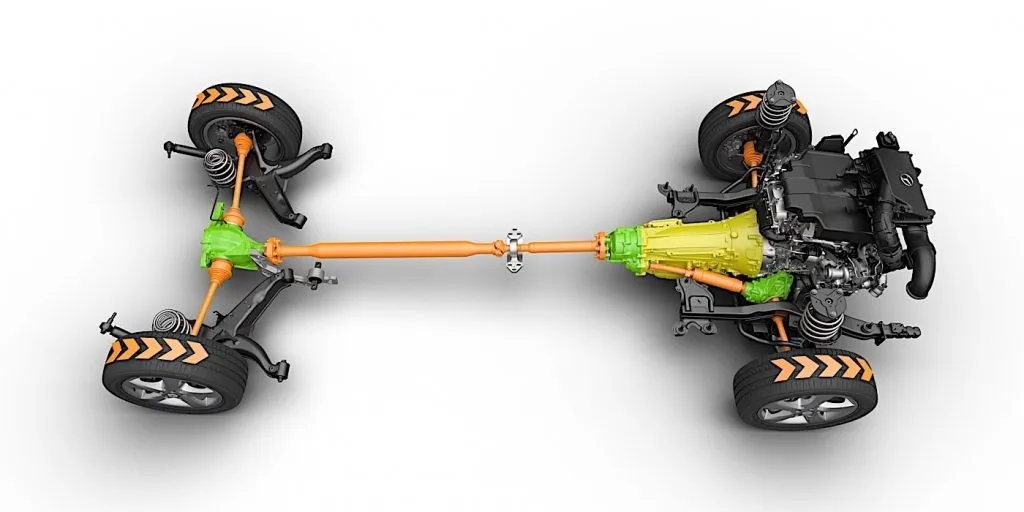Drivetrain
The drivetrain of a vehicle is a critical system that transmits power from the engine to the wheels, enabling the vehicle to move. It includes various components such as the engine, transmission, driveshaft, differential, axles, and wheel hubs. These parts work together to transfer power and ensure the vehicle operates efficiently, smoothly, and safely.

LEARN ABOUT THE DRIVETRAIN:
The drivetrain of a vehicle refers to the system of components responsible for transmitting power from the engine to the wheels. It plays a critical role in a vehicle's ability to move, accelerate, handle, and perform efficiently. The key components of the drivetrain include the engine, transmission, differentials, and drive axles. Each of these parts plays a specific role, and regular maintenance is crucial for ensuring their longevity and optimal performance.
Here’s an explanation of the importance of each component, as well as the benefits of regular maintenance:
1. Engine
Importance: The engine is the heart of the vehicle’s drivetrain, as it generates the power required to drive the vehicle. Whether it's an internal combustion engine or an electric motor, the engine produces energy that is transmitted through the drivetrain to the wheels. In traditional vehicles, the engine runs on gasoline or diesel fuel, while in electric vehicles (EVs), the engine (or motor) is powered by a battery.
- Power Generation: The engine provides the force needed to move the vehicle.
- Efficiency: The engine's performance directly affects fuel economy, emissions, and driving experience.
- Vital for All Drivetrain Components: Without a properly functioning engine, no other drivetrain components can operate.
Benefits of Maintenance:
- Improved Fuel Efficiency: Regular oil changes, air filter replacements, and spark plug maintenance help the engine run more efficiently, improving fuel economy.
- Prevent Engine Failure: Maintenance tasks such as monitoring cooling systems (radiator, thermostat) and replacing timing belts prevent overheating and damage to internal components.
- Longevity: Timely maintenance extends the life of the engine by ensuring optimal lubrication and preventing major failures like a blown gasket or piston damage.
2. Transmission
Importance: The transmission is responsible for converting the engine's power into usable force to turn the wheels, adjusting the vehicle’s speed and torque. It does this by using a set of gears that shift as the vehicle accelerates, decelerates, or changes direction.
- Power Conversion: The transmission alters the engine's output to suit driving conditions, allowing the vehicle to operate at different speeds and with varying amounts of torque.
- Smooth Shifting: Proper transmission operation ensures smooth gear shifts and prevents jerky movements.
- Efficiency: A well-functioning transmission helps optimize fuel efficiency by ensuring the engine runs at an optimal RPM (revolutions per minute).
Benefits of Maintenance:
- Smooth Gear Shifts: Regular fluid checks and changes prevent slipping, hard shifting, or grinding gears.
- Prevention of Transmission Failure: Transmission fluid lubricates the gears and components. Neglecting fluid changes can cause overheating and eventual breakdowns, which are often costly to repair.
- Extended Lifespan: Regular maintenance can extend the transmission’s life by keeping it properly lubricated, reducing friction, and preventing sludge buildup that can lead to wear.
3. Differentials
Importance: The differential is a key component that allows the wheels on the same axle to rotate at different speeds. This is especially important when turning, as the inside wheels need to travel a shorter distance than the outside wheels. The differential is typically located between the drive wheels and can vary in design, with front, rear, or all-wheel-drive vehicles having different configurations.
- Power Distribution: The differential distributes engine power between the left and right wheels, allowing them to rotate at different speeds when turning.
- Traction and Stability: In vehicles with all-wheel-drive (AWD) or four-wheel-drive (4WD), the differential ensures power is sent to the wheels with the most traction.
- Handling: Proper functioning of the differential allows for smoother and safer handling, especially in turns.
Benefits of Maintenance:
- Prevention of Wear: Regular checks of the differential fluid (or oil) ensure the gears inside are well-lubricated, reducing the risk of overheating or wearing down.
- Increased Traction: Ensuring the differential is in good condition allows for optimal traction, especially under challenging driving conditions like wet or icy roads.
- Avoiding Costly Repairs: Differential failure can lead to expensive repairs, including replacement of the entire assembly. Routine fluid changes and inspections can catch potential issues early, saving money in the long run.
4. Drive Axles
Importance: The drive axles connect the differential to the wheels, transmitting the rotational force to turn the wheels. They are essential for vehicles with rear-wheel drive (RWD), front-wheel drive (FWD), and all-wheel drive (AWD). Axles include the half-shafts, which carry the rotational force to the wheels, and CV joints (constant velocity joints) in front-wheel-drive or all-wheel-drive vehicles, which allow for smooth power delivery while accommodating suspension movement.
- Torque Transfer: Axles transfer the rotational power from the differential to the wheels, enabling the vehicle to move.
- Wheel Movement: The axles allow the wheels to move up and down with the suspension system while maintaining a connection to the drivetrain.
- Handling and Safety: Drive axles are crucial for stability, especially in vehicles with complex drivetrain systems (like AWD or 4WD).
Benefits of Maintenance:
- Preventing Vibration and Noise: Regularly inspecting and maintaining the axles (especially CV joints and boots) can prevent issues like clicking noises, vibrations, or loss of power during turns.
- Avoiding Breakdown: Damaged CV joints or axles can lead to the loss of power to the wheels, making the vehicle undriveable. Routine maintenance helps catch these issues before they cause a failure.
- Extending the Life of the Drivetrain: Well-maintained axles and CV joints help prevent excessive wear on other drivetrain components (like the differential or transmission), preserving the entire system's longevity.
By maintaining the engine, transmission, differential, and drive axles, you ensure that the drivetrain operates efficiently, safely, and lasts as long as possible. Regular checks, fluid changes, and inspections are key to avoiding premature wear and avoiding costly repairs down the line.